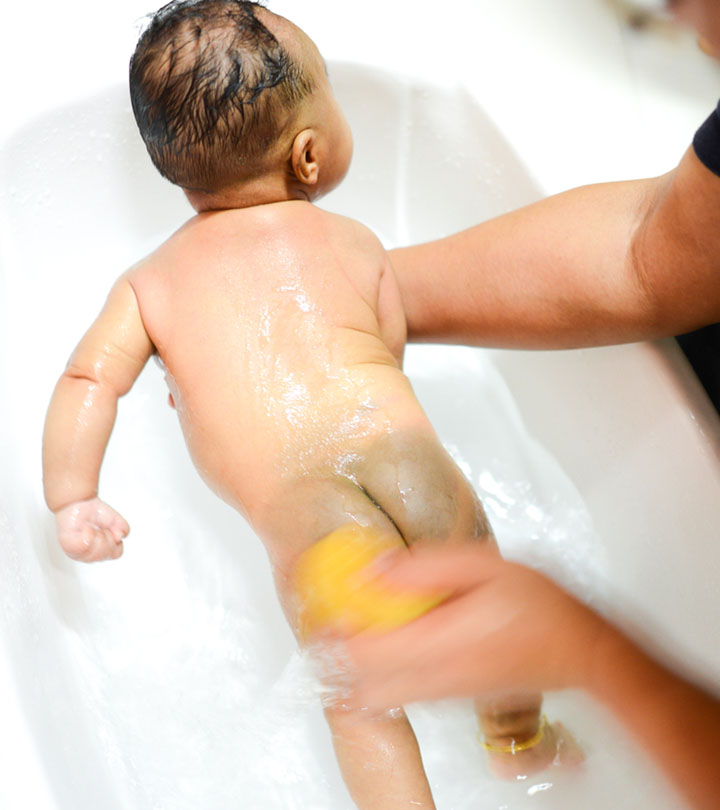Mongolian blue spots, also referred to as congenital dermal melanocytosis, slate gray nevus, dermal melanocytosis, or lumbosacral dermal melanocytosis, are a type of birthmarks having a flat, blue or blue-gray appearance. These spots appear at the base of the spine or in the areas of the upper back, buttocks, or shoulders. Some babies may have these spots from birth, while others may develop them a few weeks later.
This post explains the various causes, signs and symptoms, diagnosis, treatment methods, and prognosis of Mongolian blue spots in babies.
What Causes Mongolian Blue Spots In Babies?
Mongolian blue spots or Mongolian spots appear due to the collection of melanocytes (pigment cells) in the skin’s deep layer. Entrapment of melanocytes in the dermis (deep layer of skin) usually occurs during embryonic development, and they fail to reach the epidermis (superficial layer of the skin). Melanocytes make skin pigment called melanin. Thus, the accumulation of these cells could result in the development of bluish or bluish-gray skin pigmentations or marks, known as Mongolian blue spots, on the newborn skin (1).
Extensive spots might indicate inborn errors of metabolism and vascular pathologies (2). However, in most cases, Mongolian spots are benign.
The birthmark tends to be more common in people with Asian, Native American, Hispanic, East Indian, and African ethnicities. It was originally believed to have been present only in those of Mongolian descent, hence the name.
Symptoms And Signs Of Mongolian Blue Spots
Mongolian blue spots are not painful and do not cause any serious symptoms for the babies. Parents may notice the following features of Mongolian blue spots (3).
- Blue or blue-gray spots that commonly appear on the back, buttock, or shoulders
- The spot may appear flat with unclear border and irregular shape
- Each spot could usually be two to eight centimeter wide
- Non-blanching (do not fade under pressure)
- The texture of the surrounding skin would be normal
The birthmark may also appear on the face, limbs, or any other part of the body and are called Ectopic Mongolian Spots. In rare cases, it can be mistaken for bruises that may arise due to trauma or child abuse.
Mongolian blue spots may sometimes cover large areas of the skin. However, these spots are not cancerous and are mostly benign birthmarks. There won’t be any changes in the skin other than the color of the birthmark.
Diagnosis Of Mongolian Blue Spots
Doctors can diagnose Mongolian blue spots by observing the newborn’s skin. The pediatrician usually evaluates all types of birthmarks during the routine newborn examination. There is no test required to diagnose Mongolian blue spots. In rare cases, healthcare professionals may order some tests if they suspect any underlying dermatological conditions.
Treatment For Mongolian Blue Spots
Mongolian blue spots do not require treatment if they are normal birthmarks.
However, if testing reveals other underlying conditions causing skin discoloration, the doctor may design a treatment option that is suitable to address that condition. You may discuss with a pediatrician for the individual treatment plan.
Prognosis Of Mongolian Blue Spots
In many cases, the normal birthmarks may fade away by age four or during teenage. However, more extensive and persistent melanocytosis may tend to stay for several years or a lifetime.
Mongolian blue spots are not a sign of any disease. Instead, they are blue-gray spots or pigmented birthmarks that appear due to the collection of melanocytes in the deeper layers of the skin. Although these spots are not a cause for concern, it is advised to consult with the doctor for the proper diagnosis of the cause of the spots. In addition, one should remember that these spots are not a sign of skin cancer and do not cause any pain. But, in case your baby experiences pain and other symptoms, consult the doctor promptly.
Key Pointers
- While most Mongolian spots are benign, extensive spots may signify inborn metabolic and vascular pathologies.
- Blue or blue-gray color patches on the back, buttocks, or shoulders of neonates are prevalent.
- If Mongolian blue spots appear as birthmarks, no treatment is necessary.
- If the mark is extensive, a pediatric dermatologist evaluation is advised to rule out any underlying disorders.
Learn from this video about Congenital Dermal Melanosis, also known as Mongolian Spots. Discover what causes them and how they can be treated.












